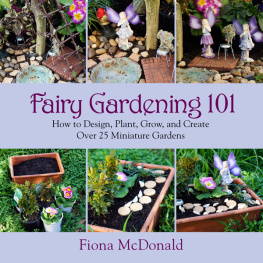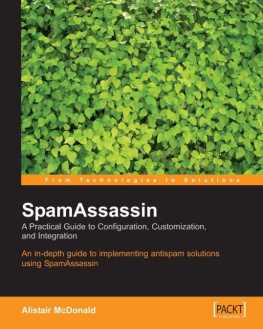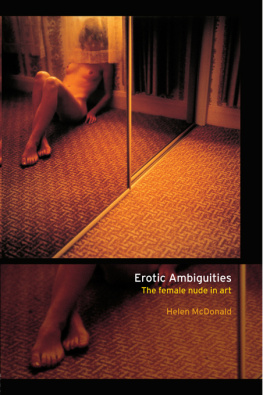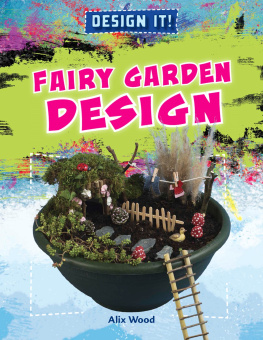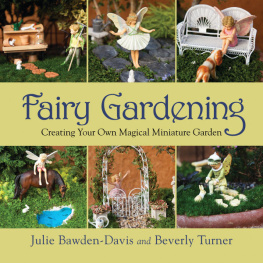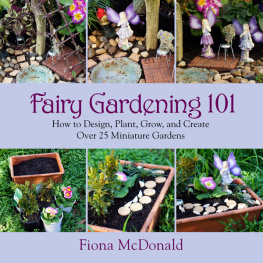
Miniature equipment for a fairy gardener,
photo courtesy of Rose Mannering
Copyright 2014 by Fiona McDonald
All rights reserved. No part of this book may be reproduced in any manner without the express written consent of the publisher, except in the case of brief excerpts in critical reviews or articles. All inquiries should be addressed to Skyhorse Publishing, 307 West 36th Street, 11th Floor, New York, NY 10018.
Skyhorse Publishing books may be purchased in bulk at special discounts for sales promotion, corporate gifts, fund-raising, or educational purposes. Special editions can also be created to specifications. For details, contact the Special Sales Department, Skyhorse Publishing, 307 West 36th Street, 11th Floor, New York, NY 10018 or .
Skyhorse and Skyhorse Publishing are registered trademarks of Skyhorse Publishing, Inc., a Delaware corporation.
Visit our website at www.skyhorsepublishing.com.
10 9 8 7 6 5 4 3 2 1
Library of Congress Cataloging-in-Publication Data
McDonald, Fiona.
Fairy gardening 101: how to design, plant, grow, and create over 25 miniature gardens/Fiona McDonald.
pages cm
Other title: How to design, plant, grow, and create over 25 miniature gardens
ISBN 978-1-62914-179-4 (pbk.: alk. paper) 1. Gardens, Miniature. 2. Miniature plants. I. Title. II. Title: How to design, plant, grow, and create over 25 miniature gardens.
SB433.5.M33 2014
635dc23
2014007189
Cover design by Eve Siegel
Cover photos by Fiona McDonald
ISBN: 978-1-62914-179-4
Ebook ISBN: 978-1-62914-282-1
Printed in China
To my granddaughters, Isabelle and Charlotte,
who often look for fairies in the garden.
CONTENTS
Introduction

Photo courtesy of Patti at Wholesale Fairy Gardens
Thorn, Ash and Oak are their favorite trees
So perhaps you could circle the boughs with these:
Some Foxgloves for thimbles, some Thyme for a treat
Bluebells for their magic and logs for a seat!
Plant Primrose and eat them if you dare by the day
and it is said by the evening youll glance a few Fey!
Believe in the fairies who make dreams come true.
Believe in the magic from the fairies above,
They dance in the flowers and sing songs of love.
And if you believe and always stay true,
The fairies will be there to watch over you.
John Atkinson Grimshaw
W ho hasnt once gone looking for fairies at the edge of the garden?
My cousin and I were always peering into roses, under daisies, and in the overgrown honeysuckle hoping to catch the briefest glimpse of a tiny winged being. A flicker of iridescent blue, a flash of soft pink, and a giggle that was gone before it had begun; these were surely signs of fairies inhabiting our garden oasis.
If you believe in these tiny nature spirits and would really like to make their acquaintance, then there are ways of enticing them into your garden. Of course, if you have a large, overgrown, and private yard, you are halfway there. Fairies are timid of us big folk and need places to hide in case of danger.
Fairies adore flowers, so plants with lots of color and pretty aroma are very attractive to them. A variety of sizes is a good idea as well. Tiny flowers can be used by fairy maidens as headdresses and garlands; larger flowers can become luxurious beds on which fairies can rest after a hard days work.
Trees, too, are a great addition if your garden is big enough. Fairies have natural affinities with certain trees: oak, elm, ash, blackthorn, hazel, and alder are preferred, as are thorn bushes. Some of these have their own special spirits. Willow trees, for example, contain spirits that are a lot like cranky old men and have been known to pull up their roots during the night and to move around. Rowan, on the other hand, was often used to ward off evil spirits, including members of the fairy folk.
A Brief History of Fairies
By the craggy hill-side,
Through the mosses bare,
They have planted thorn-trees
For pleasure here and there.
Is any man so daring
As dig them up in spite,
He shall find their sharpest thorns
In his bed at night
William Allingham
Fairy beings belong to all cultures and all times but the word fairy itself has an interesting origin and was not in use before the Middle Ages. It evolved out of the Italian word fatae , which was the name given to fairy ladies who were guests at christenings and who were called upon to bless the child (and we all know that it is a bad move to forget to invite any of these or your child might be given a century-long nap). It was a name that came from the pre-Christian belief in the Fates, who were integrated into Roman mythology from Ancient Greece.
The French took the word fatae from their Italian neighbors and made it faie and added erie , but even though the result sounded like the word we know today its meaning was one of being enchanted. Over time, faerie changed to become a noun referring to a supernatural race of creatures from the Celtic fairy realm. This included the Seelie Court (fair and good) and the Unseelie Court (dark and wicked), trooping fairies (sometimes human sized who like to parade on their beautiful horses in sparkling armor), pixies, elves, leprechauns (typically Irish), brownies, boggles, boggarts, banshees, and tiny winged humans with mischievous magic powers.
It is this last groupthe tiny winged humansthat most of us now think of when we say fairy, and it is this group that Fairy Gardening 101 is aiming to attract into your own special garden. Now, although this is what we will attempt to do Im afraid I cannot accept any responsibility if you also attract hobgoblins, gnomes, or cobblynau into it, too. It is a fact that magic is beautiful, but it is not without risk (but I think the possibility of having a garden full of fairies is worth it).
Chapter
Things You Might Need to Create Your Fairy Garden

Y ou really do not need any expensive or exotic equipment in order to make a fairy garden. There is, however, one absolutely essential ingredient and that is imagination. Without it, I am afraid that all the best efforts of the best gardeners in the world will not succeed in bringing fairies into your garden.
It is possible to go into your own backyard or into the woods, say, when you are on a picnic, and fashion a garden out of the things around youand the result can be most satisfying. Having said that, there are a few things that make fairy gardening of any sort a little easier and more comfortable.
I like to dig earth and deal out potting soil with a trowel. We have several ancient examples kicking around the home and these weathered work tools are just the thing for digging in the soil, helping remove weeds, and back-filling potting soil.
An old butter knife is also a useful tool for making small holes in the dirt for small plants. My mother always had one sitting next to her trowel beside the back door and I recommend you keep one near your fairy garden as you plant it.

